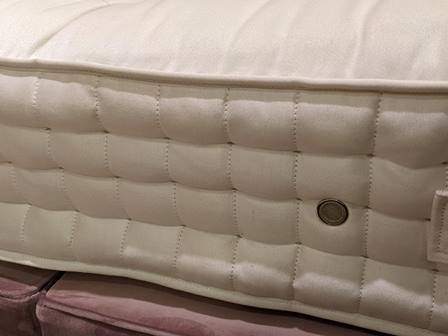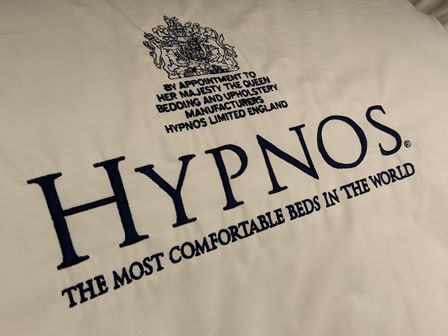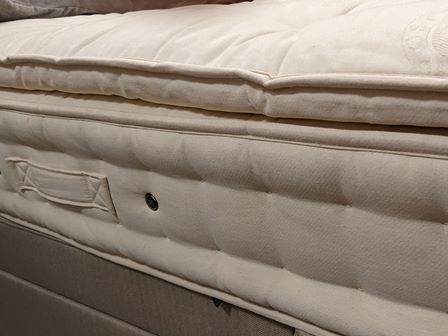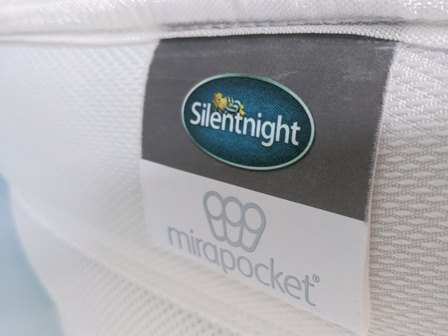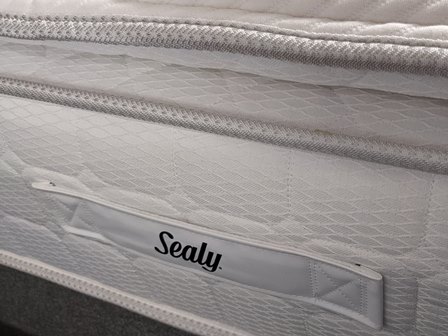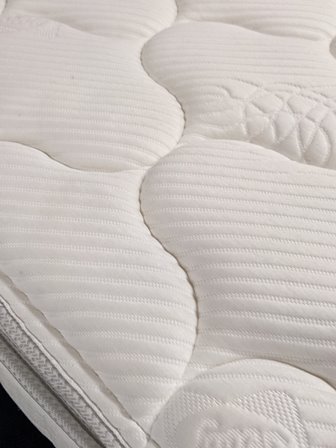Most people shopping for a good quality mattress buy a pocket spring one. Sure, memory foam and other types of mattress are popular, but most of us stick to what we know.
But that decision still needs narrowing down from a vast number of pocket spring mattresses on the market. You’ve got two options:
- Pick one from our recommended list
- Learn how to spot a quality mattress and then search one out for yourself.
Here are my six tips for buying the best pocket spring mattress you can afford:

1. (Some of) the best mattresses have won awards
OK, awards don’t mean everything. After all, Mrs Brown’s Boys was voted the best sitcom of the 21st century (apologies if you’re a fan…).
However, if you’re interested then the pocket spring mattress manufacturers which have won at the National Bed Federation’s annual industry awards in recent years have included:
- Vispring are famously known as the inventors of the pocket spring mattress. They have a sub-brand called J Marshall which makes the J Marshall No 4 mattress. It will cost you £1149 in double but it is notable as it was the winner in 2019 at the National Bed Federation Awards. It’s a medium tension mattress which has a good number of springs (1600) as well as a pillowtop layer and something called hand side stitching, which gives it strength. The downside with a pillowtop mattress is that you can’t turn it over, which is a good way of prolonging the life of a mattress. Alternatively, there’s the cheaper Vispring Plymouth Supreme 1200 (£1429) which is medium tension. The spring count is a bit lower but it will certainly offer good support and you can turn it over.
See our guide to the best Vispring mattresses.
- Hypnos won best manufacturer in 2014 and were runners up in 2013 and 2018 at the National Bed Federation Awards. If you’re after a reasonably priced firmer model then take a look at The Hypnos Orthos Elite Pocket Sprung Mattress (£759, firm). It’s double sided which means you can turn it over to help prolong its life. It also uses proper natural materials including wool and cotton. Wool is naturally good at absorbing moisture without feeling wet and it keeps you cool by regulating your temperature. Another Hypnos model around the same price is The Hypnos Luxury Wool No 1 Mattress (£1149, medium/firm tension). You’ll sometimes be able to get a discount on that model during sales.
See our guide to the best Hypnos mattresses.
- Harrison Spinks won best manufacturer at the National Bed Federation Awards in 2015 and 2018. They make the John Lewis & Partners Natural Collection as well as brands such as Somnus. Models in the John Lewis & Partners range with good reviews and specifications include the Egyptian Cotton 5900 model (£1199, medium or firm). In 2021, John Lewis & Partners introduced an offer where you can try out a mattress from the Natural Collection at home. That’s something you find offered with a lot of memory foam mattresses, but it’s less common with pocket sprung models. There are some downsides – you have to pay to return it, you have to buy a mattress protector at the same time and you have to swap it rather than getting a refund.
Harrison Spinks also make the Herdy Sleep mattress (£999, medium/firm) which is another model which has a trial period.

Other recent winners include Millbrook which was named best small manufacturer in 2018 and Steinhoff Bedding Group which was runner up in 2016. They are makers of Myer’s, Relyon and Slumberland.
Another option if you’re swayed by awards is to look at overall customer reviews for brands which specialise in pocket sprung mattresses. TrustPilot is the best website I’ve found for this sort of information, as most brands have hundreds of reviews. High scoring pocket sprung mattress brands include:
- Sleepeezee scores 4.2/5 from customers on TrustPilot and is a mid-priced mattress brand, despite having a Royal Warrant (they supply King Charles’ household). At the budget end of the range you can get a good value option such as the Backcare Deluxe (£332, firm tension). The spring count is relatively low, but it’s a good depth and it is double sided which is a good feature for the price.
If you can afford the upgrade or want a medium tension model then I would try the mid-priced Wool Supreme 2400 (£699, medium tension). For about twice the price, you get a considerable increase in spring count and a wool filling. Wool is an excellent material for mattresses as it is naturally good at keeping you at a consistent temperature. Research has shown a link between big fluctuations in temperature and poor quality sleep so wool goes some way to addressing this (Bischof, Madsen et al, 1991).
At the top of the range is the Mayfair 3200 (£999, medium). For the upgrade you get another increase in pocket springs, although they are spread over more than one layer once you get into big numbers like this. On the downside, you can’t turn this mattress over but on the plus side, it has a warranty of 10 years rather than the 5 years you get with the cheaper models.
See our guide to the best Sleepeezee mattresses.

- Silentnight scores 4.1/5 from customers. They’re a huge brand which sells a range of types of beds, including plenty of mid-priced pocket sprung mattresses.
A solid and mid-priced model which is a huge seller is the Sofia 1200 (£449, medium/firm). We chose this one for my mum’s spare room as it’s a good specification for the price and it won a big award from experts. The pocket spring count is plenty for most people and it can be turned over to help it last longer. I would personally avoid very soft or very firm mattresses for a guest bedroom – a medium or medium firm model is more likely to provide a suitable level of comfort to most people.
The London Stratus (£511, medium) is slightly more expensive but it’s designed in a different way. You get a layer of memory foam on top, which makes it a ‘hybrid’ mattress. Memory foam bounces back slower than other materials which gives it more of a hugging feeling. One downside is that it can make you feel warm. It is also less ‘natural’ than wool or cotton and some studies have claimed it has a ‘higher environmental impact’ that other materials (Lanoë, Simões et al, 2013).
See our guide to the best Silentnight mattresses.

(For the TrustPilot reviews, we looked at the brand’s overall ‘Trust Score’ and searched in 2023. We didn’t include some brands which just had a tiny number of reviews and we didn’t include brands which sell dozens of other things, such as IKEA, as it wouldn’t tell us a lot about their mattresses. We couldn’t find reviews for some well known pocket spring brands, such as Somnus).
Another option is to look at independent tests which are carried out on pocket spring mattresses. Award winners/those which scored very well include:
Silentnight 1200 Classic Pocket Deluxe – £449 – as mentioned earlier, this medium/firm pocket spring mattress is from the biggest name in the UK mattress market. It’s also called the ‘Sofia’ and I’d consider it a safe option for a lot of people, as it has a huge number of positive customer reviews. It is also double sided, whereas lots of mattresses around this price can’t be flipped over. If you actually get around to turning a mattress over then this is a good feature and should reduce the risk of developing indents over time.
[affcoups id=”3327″]
Sealy Teramo 1400 – £599 – this pocket spring mattress has 1400 springs and a layer of natural latex on top. If you’re buying a latex mattress make sure that you check a) whether it is natural or synthetic latex (the former is better) and b) how thick the layer of latex is. In this case, the latex layer is 2.5cm, which is not huge but it does provide a comfortable layer on top of the springs. It’s made by a big name brand and is a soft/medium mattress which makes it more suited to lighter people. You’ll find it also called the Nostromo in showrooms. After comparing specifications, we can’t see any difference between the Teramo and the Nostromo.
[affcoups id=”3299″]
Yet another option is to look for a mattress maker with a ‘Manufacturing Guild Mark’ which is an award handed out by the Furniture Makers Company. According to the blurb, it is ‘awarded to British manufacturers that have demonstrated incredible standards across all areas of the business by successfully passing a rigorous, independently reviewed audit’. Awardees include:
- Harrison Spinks which makes the John Lewis & Partners Natural Collection (as mentioned earlier) and the Herdy Sleep mattress.
- Relyon, which is a long established mid-priced pocket spring mattress brand (about £300 – £1000 for a double)
One final option for Royalists is to go for a mattress brand which has been awarded a Royal Warrant, meaning that they’re used by royal households. The two main ones are:
- Sleepeezee (mid-priced brand, 4.2/5 on TrustPilot)
- Hypnos (mostly luxury priced, 3.6/5 on TrustPilot)
Along similar lines, Vispring is a previous holder of the Queen’s Award for Enterprise, which is a big deal.
2. The best mattresses are (usually) the most expensive ones
Well, derrrrr…
Bear with me and let me explain what I mean.
Everyone loves to feel they are getting a bargain, but broadly speaking you get what you pay for with a mattress. Sure, there are discount codes and the like, but don’t get sucked in by the big red sale sticker in the shop offering 70% off.
Don’t get me wrong, a retailer like Furniture Village or John Lewis & Partners will sometimes 20% – 30% off a good quality mattress in a sale, but there are other bed retailers who seem to always have a massive sale on, which makes me suspicious.
In summary, a bed reduced from £2000 to £700 will most likely be a very similar quality to one which costs £700 elsewhere.

3. The best mattresses have at least 1000 springs
Very cheap pocket spring mattresses try to get away with 600 springs. From the many guides I’ve read online, the consensus seems to be that if you can afford an upgrade to at least 1000 springs then you’ll feel the benefit.
If you don’t weigh a lot then 1000 should provide plenty of support, but if your idea of a balanced diet is a pie in each hand then you will probably want something closer to 2000 springs.
You will see mattresses offering silly numbers of springs (some go over 10,000) but the advantages diminish simply because of how many springs will fit on one layer of a mattress. I’ve seen John Lewis selling mattresses with 26400 springs, but most of them are very small springs to provide a bit of extra support rather than full size pocket springs.
An interesting question (in my opinion) is how clear the correlation is between how much a mattress costs and how many springs it has.
We looked into this by looking at the spring count versus cost of Vispring mattresses and Hypnos mattresses and came up with the following data:


As you can see, there is a clear correlation between cost and the number of pocket springs with Vispring mattresses. It’s less apparent with Hypnos but the general pattern is the same.
However, I would caution from applying the same assumption between different mattress brands. It is only one factor and you will find that you get some confusing results. To test this out, we applied the same data to mattresses featured in our guide to the best pocket spring mattresses, which includes several different brands.

This time, the data is more confusing as one of the mattresses advertised a huge number of springs, many of which are much smaller. Also, there wasn’t much correlation between the other four mattresses, with one of the most expensive mattresses having a lower spring count than a mid-priced model. If there was a clear correlation, you’d expect to see a diagonal line starting from where the X axis meets the Y axis.
My conclusion is that once you start comparing brands, the pocket spring count is only one factor and shouldn’t be given as much weight as when you are comparing several mattresses by the same brand.
4. (Most of) the best mattresses are hand tufted
Take a look at the top of a mattress and it will either by quilted (completely flat) or hand tufted (bumpy with buttons holding it all in place).
The very best quality pocket spring mattresses are nearly always hand tufted.
Now, before I get angry emails from quilted mattress sellers, it’s worth saying that there are many high quality quilted mattresses and we recommended several in our guide to 10 of the best mattresses on the market.
My point though is that brands like Hypnos (the Royal Family’s mattress maker), and Vispring make mostly hand tufted mattresses and they all offer mattresses which cost more than my first car.
I’ve also read compelling arguments of why hand tufted mattresses are better and more stable, but I won’t bore you with excessive detail.
On the down side, bear in mind that hand tufted mattresses need turning regularly whilst many quilted mattresses are no turn. Not turning your mattress is convenient (I need two weeks of physio every time I turn our huge mattress) but most people say that a mattress that you flip over will flipping well last longer.
A no turn mattress may be a necessity of having a high quality comfort topper on the mattress…or it may just be a way of using cheaper materials on the bottom half of the mattress.


5. The best mattresses have hand side stitching
Honestly, my attempts to turn mattress seller jargon into something in plain English had me scratching my head many times. I won’t bore you with the details, but the summary is that something called ‘Hand Side Stitching’ is a sign of quality, whereas ‘Machine Side Stitching’ isn’t so good.
It’s to do with how much support your bed offers at the edges and there are two ways to work out what a particular mattress offers.
The first option is to visit your local bed shop and start sitting on the sides of all their pocket spring mattresses. Cheap mattresses bulge out at the side whilst the best mattresses won’t. (I can’t help feeling you might get thrown out of Dreams if you turn up with a tape measure and start measure the size of their bulges, but hey…)
The second option for spotting Hand Side Stitching is to look for it in the descriptions online, which is certainly less effort (although many websites don’t seem to declare it which doesn’t help). John Lewis & Partners is a shining example of a retailer which clearly describes how their mattresses are made.
As a general rule, if a company doesn’t say that a mattress is Hand Side Stitched then it probably isn’t, as it is something you would shout about. In the same way that you might assume that your local greasy kebab takeaway probably isn’t selling organic, free range meat, unless it makes a point of saying it is.
For a bit of deeper analysis, we looked at the cost of 14 mattresses sold under the John Lewis & Partners brand, including their budget and more luxurious collections. We looked at a range of prices and whether they had hand side stitching or machine side stitching. We looked at seven mattresses which cost less than £500 for a double size and seven which cost £500-£1000 for a double size.

As you can see, the vast majority of the more expensive mattresses used hand side stitching whilst the cheaper mattresses were split between those that used machine side stitching and hand side stitching.
6. The best mattresses have a woven cover
Here’s another question which baffled me: Which is the best material for a mattress cover? I read so many guides about Belgian damask whatevers and woven fabric thingyamajigs and I was still confused.
Here’s the summary to save you the dull journey I went on:
Don’t buy a bed with a stitch bond cover. They are rough and unpleasant and are the kind of thing you’d see on a children’s mattress at your local tip or dumped in a hedgerow.
Beyond that, most natural woven fabrics seem to be fine – such as cotton or damask. There’s also a huge range of mattress covers with silly names which sound like they were thought up by throwing scientific names into a hat and pulling out a handful. It’s hard to sift the genuine scientific developments from the pseudo-science waffle on this one, so I would be cautious about buying a mattress just because it had a long name.

